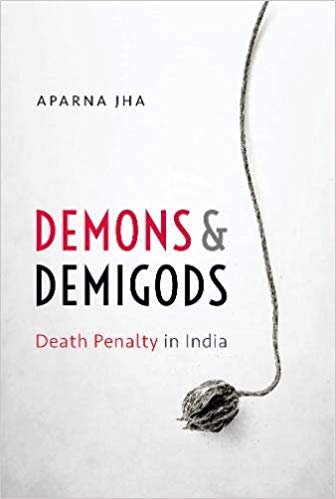Extracts from
Demons and Demigods: Death Penalty in India

The harshest punishment is reserved for the hardest crimes. Murderers, rapists, terrorists — perpetrators of grisly acts — these are the people on the death row. The Supreme Court of India has repeatedly held that the death penalty can be awarded only in the rarest of rare cases, where guilt is proved beyond a reasonable doubt. Yet, who is to say what that may be? For witnesses can be lie and evidence be tampered with. In a system that is imperfect, not all those found guilty are truly demons, nor those who pass the sentence demigods, flawless and beyond research. The book, Demons and Demigods: Death Penalty in India, written by Aparna Jha, makes a case against capital punishment.
The following are extracts from “Bachan Singh” and “The Law is Not Mathematics” chapters of the book.
Though the top court refused to restrict judicial discretion by making an exhaustive list of aggravating and mitigating factors, some guidelines were laid down. A balance sheet had to be drawn after both kinds of circumstances had been considered in a case. The mitigating circumstances included offence committed under the influence of extreme mental or emotional disturbance, or the age of the accused (that is, if the attacker was very young or very old). A young mind was immature, unable to differentiate between right and wrong. Therefore, they decided that the young should not be hanged if they had done something in fit of passion. Likewise, the court felt that an old and frail convict would hardly be threat to the society. They should not face the hangman’s noose.
Post-murder remorse was, again, considered a mitigating factor. It implied that the accused could be reformed. In that case, they were to be pardoned. The fact that the accused had acted under duress or domination of another person, or that they thought they had been morally justified in killing their victims was also a mitigating factor.
I knew it was alleged that my boys had killed 10 people in a most horrific manner. How would the top court view the act? But they were young boys, too. I noted this down and went through the papers to find out exactly how old they were when they had supposedly killed.
The top court discussed all the aspects of death penalty at length. Another point to be considered while deciding whether a person should be hanged or spared was their mental state. A mentally unstable person did not know what they were doing. They were like children, unaware of the consequences of their actions. The judges felt that such a person did not deserve to die.
The court also gave some examples of aggravating circumstances where the death penalty should be given. For example, when the offender had killed someone who belonged to a Scheduled Caste or a Scheduled Tribe, that is, in brutal killings of those who belonged to the backward castes.
Another aggravating circumstance was the killing of a national leader, a policeman, or public servant on duty. If the murder involved extreme depravity or brutality, or was planned, it was yet another aggravating factor.
[…]
Raju and Josephine may have killed her after a heated argument, or after they had stolen expensive pieces of Shakereh’s jewellery. People kill for a single gold chain… or even for a few hundred rupees.
Or, Swamy Shraddananda and the servants may have conspired together in the semi-darkness, sitting under leafy trees that stood as mute spectators. And while the swamy was caught, the others were not.
Judges are not gods, though they have been entrusted with a job that demands god-like powers. The brightest and the most well-meaning judge can make a mistake. This is what Justice Sinha meant when he said in Swamy Shraddananda’s case that where the sole basis of judgment is circumstantial evidence, there are far greater chances of wrongful convictions in comparison to cases that are based on concrete proof. He had strongly advocated in Swamy Shraddananda’s case that the death penalty should go; it had already been done away with in many countries.
Justice Sinha’s words made perfect sense to me. My case was also based on circumstantial evidence. I emphasized this point several times over while drafting it. There wasn’t a single eyewitness. At times, a watertight case against the accused can later turn out to be an instance of a perfect frame-up. Where there is no eyewitness at all—as in my case—there was obviously enough margin for error. The death penalty could not be awarded simply on the basis of circumstantial evidence. As in Swamy Shraddananda’s case, no one actually saw the murders taking place. It was mere conjecture and shooting arrows in the dark. The opponents were just trying to put two and two together to arrive at a figure they wanted.
The judges in the Supreme Court are generally above sixty, with a great deal of knowledge and experience behind them. But no one is infallible. The law is not mathematics, where two and two make four. No one can say with certainty that an accused is guilty of the crime; there are multiple scenarios possible. It is all based on possibilities and probabilities. The task before the judges is much more onerous in a case where they have to take away a citizen’s most fundamental right: the right to live. Two judges may hold different positions given the same set of facts.
Courtesy: Indian Cultural Forum
